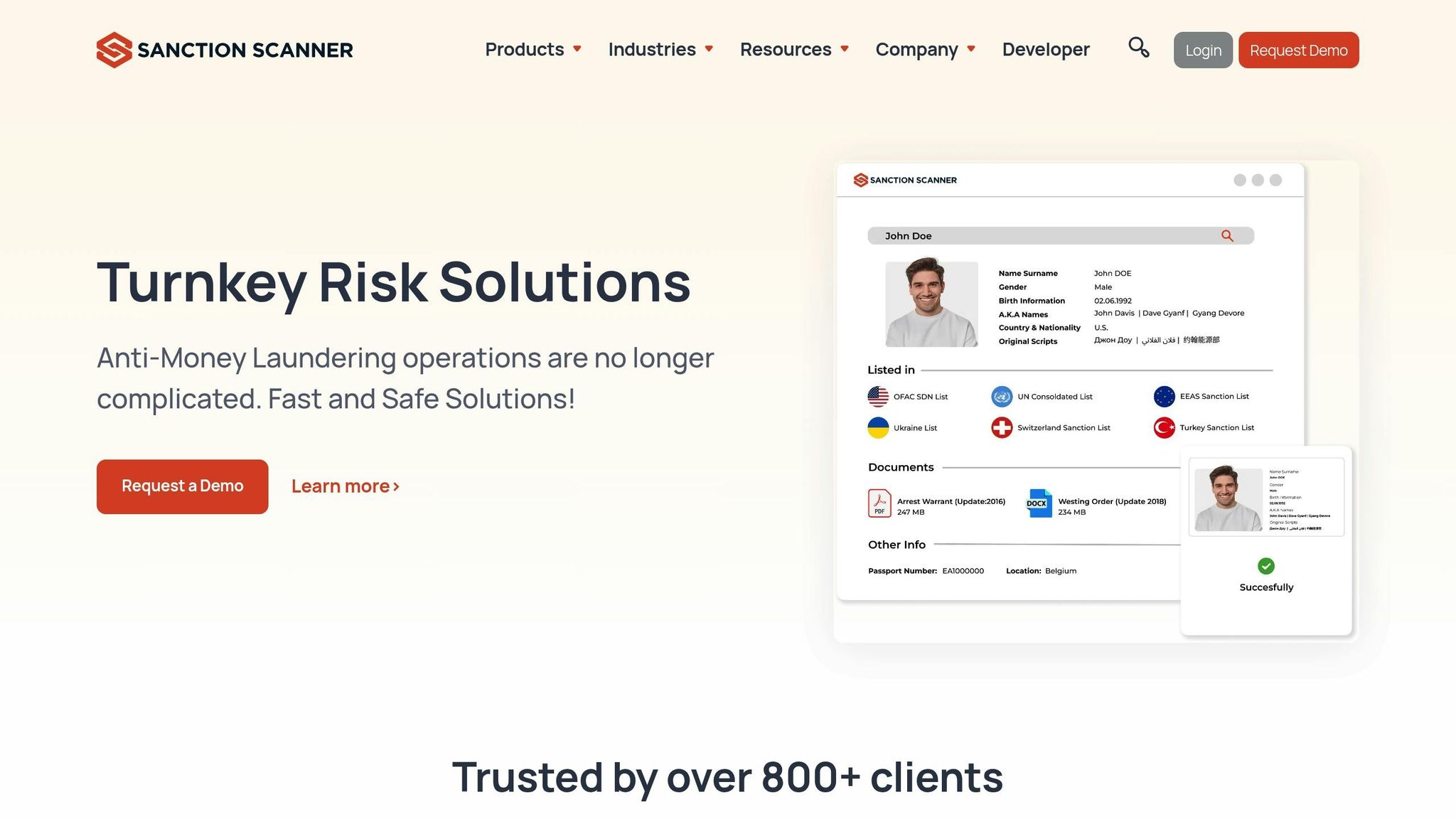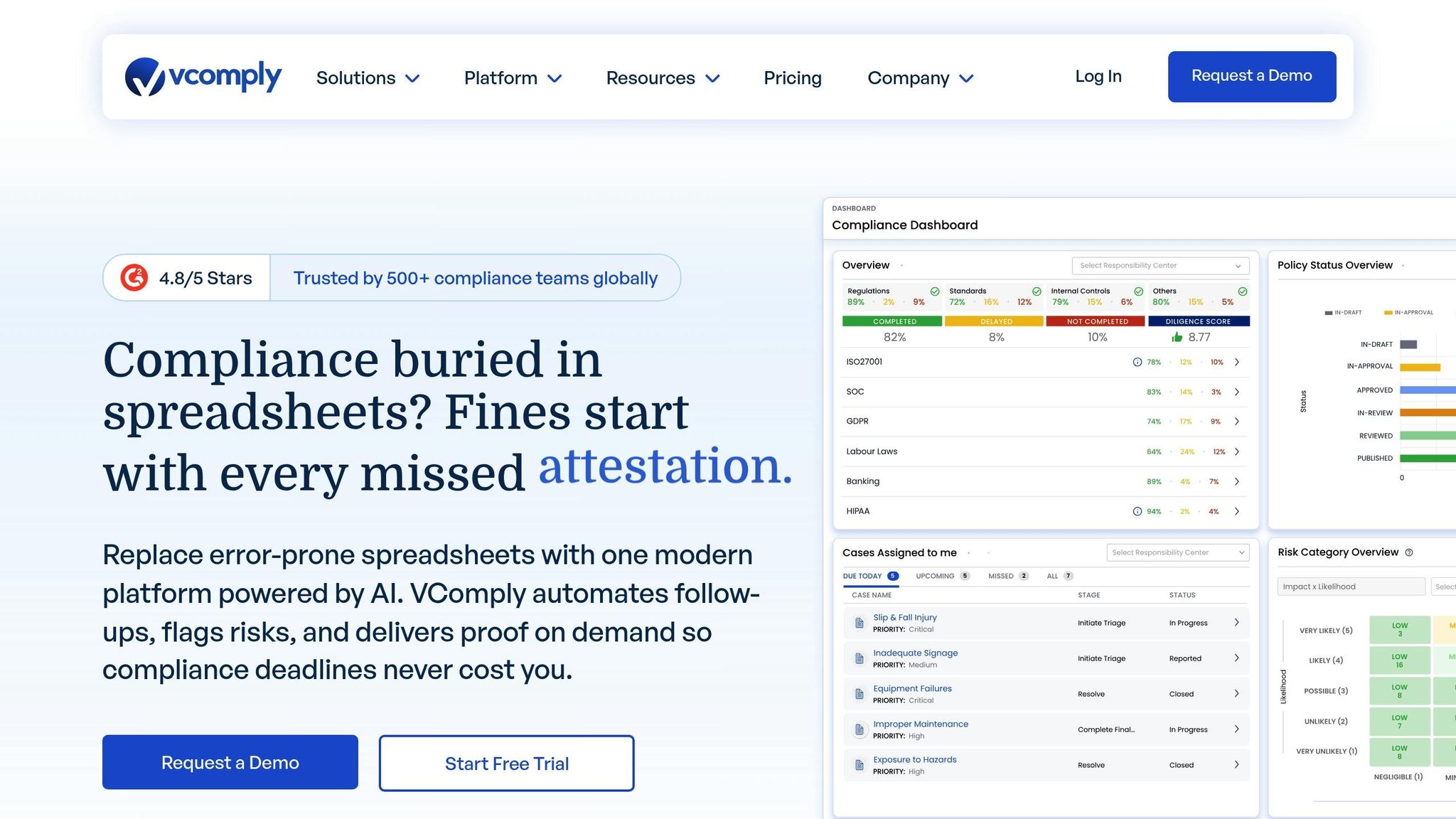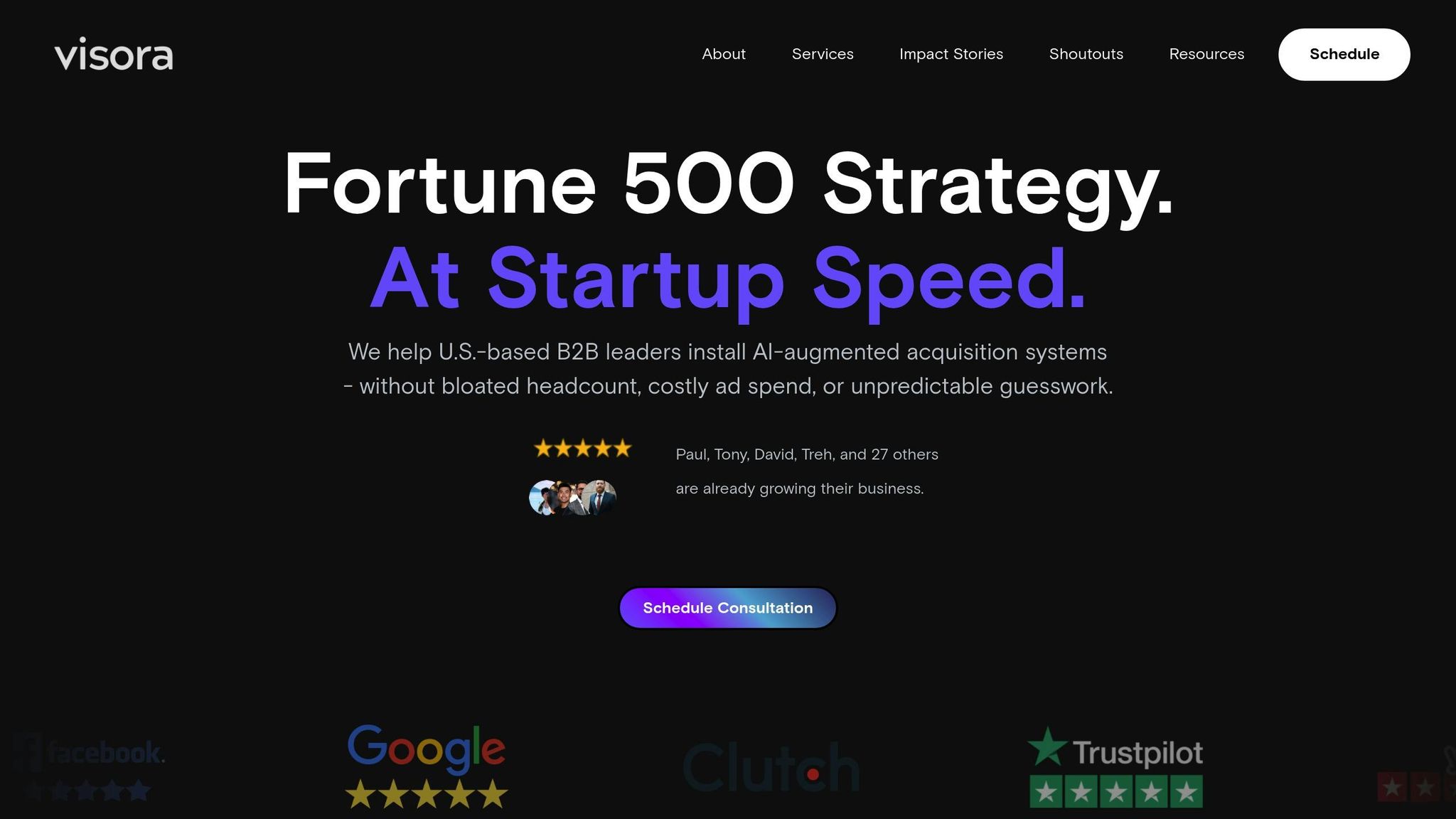
Managing compliance in financial services is more demanding than ever. With constant regulatory updates from agencies like the SEC and FINRA, firms need tools to stay compliant, reduce risks, and improve efficiency. Modern compliance platforms use AI and automation to simplify processes like AML screening, customer onboarding, and regulatory reporting. This shift has led to:
Key features to look for include:
Here’s a quick look at six top tools:
These platforms help financial firms stay compliant while improving operational efficiency. The right tool depends on your regulatory needs, team structure, and existing systems.
Picking the right compliance tool is a critical decision in the financial services industry. It’s not just about avoiding fines - it’s also about protecting your reputation. Here’s what you should focus on to ensure you select a tool that fits your needs and keeps your business on the right track.
A good compliance tool should align with the specific regulatory frameworks that apply to your business. If there are gaps in coverage, you risk audit failures and potential legal trouble. Tools that support multiple frameworks at once can simplify audits and reduce redundant processes. For example, platforms with smart mapping features can align overlapping regulatory requirements, cutting down on inefficiencies.
But don’t settle for tools that simply meet minimum requirements. Look for platforms that help you stay ahead of evolving regulations. Features like automatic updates and real-time monitoring of new guidelines from agencies like the SEC or FINRA can make a big difference in keeping you compliant without constant manual oversight.
The best compliance tools make use of automation and artificial intelligence to handle tasks that would otherwise require significant manual effort. Some of the most helpful features include workflow automation, predictive analytics, real-time monitoring, and automated evidence collection.
These features not only save time but also help you stay proactive in managing compliance risks.
Integration capabilities are another critical factor. Your compliance tool should work seamlessly with the technology you already use, such as CRM, ERP, or HR systems. Platforms with built-in integrations reduce the need for manual data entry and ensure data consistency across your organization.
Equally important is the tool’s ability to generate robust reports and maintain clear audit trails. Features like automated report generation, customizable dashboards, role-based access controls, and detailed activity logs make it easier to meet regulatory expectations. These tools can save significant time during audits by streamlining documentation and providing a clear record of compliance activities.
When your compliance tool combines strong regulatory coverage, advanced automation, seamless integration, and transparent reporting, it transforms compliance from a basic requirement into a strategic advantage.
When it comes to navigating the complex world of regulatory requirements in the U.S., having the right compliance tool can make all the difference. Below are six platforms that help financial services firms streamline compliance workflows and stay ahead of ever-changing regulations. Each tool offers specific features tailored to the needs of U.S.-based firms.

Sanction Scanner simplifies AML compliance by continuously screening transactions and customers against global sanction lists, including those specific to the U.S. Through its robust API, the platform integrates seamlessly with core banking systems, ensuring real-time data exchange without disrupting existing workflows. It also includes Politically Exposed Persons (PEP) monitoring, which automatically flags high-risk individuals and adjusts due diligence processes as risk profiles evolve. With ratings of 4.9/5 on G2 and 4.8/5 on Gartner, along with ISO 27001 certification and GDPR compliance, Sanction Scanner provides a secure and reliable solution.

ComplyAdvantage uses artificial intelligence to maintain constantly updated risk databases. Its real-time media monitoring scans global and U.S. news sources to identify emerging risks before they escalate. The platform’s dynamic risk scoring keeps customer and partner profiles up to date, allowing compliance teams to focus on high-priority issues. This AI-driven system has earned ratings of 4.6/5 on G2 and 4.5/5 on Gartner, reducing manual review time while improving accuracy.

Centraleyes provides a centralized approach to managing compliance for financial firms dealing with multiple regulatory frameworks. It allows users to map standards like SOX, GLBA, PCI DSS, FINRA, and state-specific regulations within a single interface. The platform’s smart mapping feature identifies overlapping requirements across frameworks, cutting down on redundant processes. Real-time dashboards and automated evidence collection further simplify audit preparation, while support for both pre-built and custom frameworks makes it adaptable to a range of institutional needs.

VComply is a cloud-based Governance, Risk, and Compliance (GRC) platform that streamlines compliance tasks. It automates task assignments, tracks progress, and sends reminders to ensure deadlines are met. The platform also generates audit-ready documentation in U.S.-standard formats, making it easier for teams to prepare for regulatory reviews. With features like version control and real-time collaboration, VComply enables distributed teams to work efficiently across various locations and time zones.

Fenergo focuses on client lifecycle management, automating processes from onboarding to ongoing monitoring. Its built-in KYC and AML workflows are specifically designed to meet U.S. regulatory requirements. By automating document collection, verification, and approval, Fenergo significantly reduces onboarding times. Continuous monitoring ensures compliance with evolving laws, while detailed audit trails support regulatory reviews. This not only improves operational efficiency but also allows compliance teams to dedicate more time to strategic initiatives.

Visora takes a different approach by integrating compliance checks directly into business development processes. Its AI-enabled tools, such as the B2B Vortex Funnel and AI Augmented Appointment Setting, combine lead generation and client acquisition with built-in regulatory safeguards. The Trifecta Program further enhances this by offering strategic consulting alongside system automation, making it particularly valuable for Real Estate Syndicate Leaders, Investor Relations professionals, and Commercial Real Estate experts. Visora's integrated solutions empower firms to scale their operations while adhering to compliance standards effectively.
Selecting the right compliance tool means evaluating how each platform meets the specific needs of U.S. financial services firms. The six tools reviewed here each have unique strengths, making them suitable for different regulatory and operational challenges. Below, we break down their performance across key factors.
Each platform shines in different areas of compliance. Sanction Scanner specializes in AML and sanctions screening, bolstered by its ISO 27001 certification. Centraleyes supports a broad range of compliance frameworks, like PCI DSS and FINRA, within a unified platform. ComplyAdvantage focuses on AML and KYC compliance with a global reach. VComply covers important U.S. standards such as SOX and PCI DSS. Fenergo offers a comprehensive solution for client lifecycle management, addressing AML, KYC, and ESG requirements. Finally, Visora, while not a dedicated compliance solution, integrates business development features that complement compliance workflows for financial services firms.
Automation plays a critical role in streamlining compliance processes, and each tool approaches it differently:
How well these tools integrate with current systems can make or break their effectiveness:
User feedback highlights how well these tools perform in real-world scenarios. Sanction Scanner leads with ratings of 4.9/5 on G2 and 4.8/5 on Gartner, reflecting strong reliability and effectiveness. ComplyAdvantage follows closely with ratings of 4.6/5 on G2 and 4.5/5 on Gartner, demonstrating solid performance in risk management and automation. While other platforms may lack public ratings, their targeted features and industry focus still provide value.
Here’s a quick summary to compare the platforms:
| Tool | Primary Strength | Best For | Key Limitation |
|---|---|---|---|
| Sanction Scanner | AML screening accuracy | Transaction monitoring & sanctions | Limited beyond AML/sanctions |
| ComplyAdvantage | AI-driven risk intelligence | Dynamic risk assessment | Focused mainly on AML/KYC |
| Centraleyes | Multi-framework management | Complex regulatory environments | May overwhelm simpler needs |
| VComply | Task automation | Distributed compliance teams | Less specialized for financial services |
| Fenergo | Client lifecycle management | Customer onboarding processes | Primarily client-focused |
| Visora | Business development integration | Growth-focused compliance workflows | Not a dedicated compliance tool |
Cost is another important factor. Most vendors offer custom pricing based on company size and specific needs. Generally, higher investment aligns with broader feature sets and greater automation, so it’s essential to match tool capabilities with your compliance priorities instead of focusing solely on price.
Implementation complexity also varies. Tools like Sanction Scanner and ComplyAdvantage have straightforward API integrations, while Centraleyes may require more setup due to its extensive framework mapping. VComply simplifies deployment with its cloud-based approach, though additional team training might be necessary. Fenergo typically involves deeper integration into client management workflows, and Visora requires coordination with existing marketing and sales systems.
The right choice depends on your firm’s regulatory focus, existing technology infrastructure, and team structure. For AML compliance, Sanction Scanner or ComplyAdvantage might be ideal. Firms juggling multiple regulatory frameworks could benefit from Centraleyes. This detailed comparison aims to guide financial services firms in selecting the best tool for their evolving compliance needs.
When it comes to automated compliance monitoring, the way you implement tools can make or break their effectiveness. Without proper planning, financial services firms risk running into integration headaches, poor user adoption, and compliance gaps. A well-thought-out approach ensures the tools work as intended and deliver real value.
Before diving into tool selection, it's crucial to take a step back and evaluate your organization's regulatory requirements and internal challenges. This groundwork helps you choose a solution that fits your needs and avoids expensive missteps.
Start by mapping out all the regulatory obligations your organization must meet, especially those tied to high-risk processes. For U.S. financial services firms, this often involves navigating requirements from agencies like the SEC, FINRA, FDIC, and state regulators. For instance, investment advisors must follow SEC custody rules under the Investment Advisers Act, while broker-dealers must comply with FINRA's suitability standards.
Next, identify pain points in your current compliance workflows. Are you dealing with duplicate data entry? Delayed reporting? A lack of clear audit trails? These are common issues that can derail compliance efforts. Benchmarking against industry peers can also shed light on areas where your program could improve and help set realistic goals.
Here's an example: A mid-sized U.S. investment firm adopted an AI-powered compliance platform and cut down manual compliance hours by 40% in just six months.
Involve key stakeholders - compliance officers, legal teams, and business leaders - in this assessment. Their insights can reveal practical challenges that might not be obvious from documentation alone. External consultants can also provide an objective take on regulatory requirements and industry practices.
Once you have a clear understanding of your needs, you're ready to move on to integration and training.
A compliance tool is only as good as its integration and the people using it. Poor integration disrupts workflows, while inadequate training can lead to low adoption and continued reliance on outdated manual processes.
Look for tools that offer pre-built API integrations with your existing systems. For example, Sanction Scanner integrates with major banking platforms, enabling seamless real-time screening without interrupting workflows.
Roll out the tool in phases. This approach allows you to catch and fix integration issues early, minimizing disruptions as you scale up. Collaboration between IT teams, compliance officers, and business units is essential here. IT experts handle the technical setup, compliance teams ensure regulatory needs are met, and business leaders provide operational insights. Regular cross-functional meetings can help align these efforts and avoid costly mistakes.
When it comes to training, tailor programs to specific roles. Combine hands-on workshops, e-learning modules, and real-world scenarios based on U.S. regulations. Designate internal champions who can support their colleagues and encourage adoption. Setting up a dedicated helpdesk for technical issues and process questions can also go a long way.
Don’t stop at initial training. Schedule regular refresher sessions to keep staff up-to-date on regulatory changes and ensure they’re using the tool effectively.
Once your tool is up and running, the next step is to monitor its performance and make adjustments as needed.
Implementing a compliance tool isn’t a one-and-done deal. It requires ongoing attention to keep up with regulatory changes, business growth, and emerging risks.
Define clear metrics to measure success, such as reductions in compliance errors, time saved on manual tasks, improved audit readiness, fewer regulatory breaches, and high user adoption rates. Automated dashboards can give you real-time insights into these metrics.
Real-time monitoring is crucial for staying ahead of risks. Alerts can notify your team of issues before they escalate, while centralized policy management ensures compliance standards are applied consistently.
For example, an investment firm reported zero regulatory breaches during an examination after implementing an AI-driven compliance platform.
Stay on top of regulatory updates using tools like Thomson Reuters Regulatory Intelligence, which tracks changes to federal and state laws in real time. This allows you to quickly update your policies and procedures.
Regularly review your compliance tool to make sure it still meets your business needs and regulatory requirements. Periodic assessments can help you identify improvement opportunities before they turn into problems. Setting up a compliance center of excellence or assigning dedicated compliance officers can provide ongoing oversight and act as a liaison with your tool vendor.
Keep the lines of communication open with your vendor. Many offer user groups or advisory boards where clients can share experiences and influence product updates. These forums can provide valuable insights to help you fine-tune your compliance program over time.
The financial services industry demands precision, speed, and unwavering adherence to regulations. In today’s increasingly complex regulatory environment, relying on manual processes is no longer practical. A single mistake can lead to steep fines and tarnished reputations, making automation tools essential for firms aiming to stay competitive while meeting compliance requirements.
Take compliance workflows as an example - many firms have reported noticeable improvements in both accuracy and speed after automating these processes. These advancements highlight a broader shift in how compliance is managed across the industry.
Features like real-time monitoring and automated updates have transitioned from being optional to absolutely necessary. With regulations changing at a rapid pace, firms need tools that can adjust instantly to new requirements. Solutions such as ComplyAdvantage and Centraleyes provide dynamic risk scoring and multi-framework mapping, enabling companies to stay ahead of regulatory changes instead of scrambling to adapt.
To maintain effective compliance, constant evaluation and thoughtful implementation are critical. Treating compliance automation as a one-off project is a mistake that can leave firms trailing behind. The most successful organizations establish dedicated teams, closely monitor ROI, and continuously review their tools to ensure they align with evolving business goals and regulatory demands.
For financial services firms in the U.S. - especially those in investment management and commercial real estate - AI-powered solutions can simplify compliance workflows while also supporting growth initiatives. This dual focus on meeting regulatory standards and driving business development positions companies to excel in an increasingly automated landscape. By integrating these tools, firms not only ensure compliance but also create opportunities for strategic growth.
The real challenge lies in how quickly compliance automation can be implemented. Delays come with a price: higher costs, increased risks, and diminished operational efficiency.
AI and automation have the potential to transform compliance processes in a big way. By simplifying workflows and cutting down on manual tasks, these tools can help improve both speed and accuracy. They can sift through massive amounts of data in no time, flag potential risks, and ensure that regulatory standards are met - all while saving time and reducing the chance of human error.
For leaders in financial services, AI-powered tools offer even more opportunities. They can help create tailored communication strategies, generate leads more effectively, and make smarter, data-driven decisions. On top of that, automation frees up teams to concentrate on more strategic, high-impact work, ultimately boosting productivity and performance.
To keep compliance tools effective as regulations shift, financial firms can turn to AI-powered solutions like those provided by Visora. These systems are designed to help leaders in the financial services sector simplify compliance tasks, stay ahead of regulatory changes, and support business growth all at once.
Visora offers a comprehensive approach with tools such as B2B Vortex Funnels, AI-enhanced appointment scheduling, and strategic consulting. These solutions not only help firms maintain compliance but also streamline operations, saving time and cutting through complexity. This allows businesses to focus on scaling their operations with greater ease and confidence.
When adopting compliance tools, financial services firms should prioritize compatibility, scalability, and efficiency. It's crucial that these tools work smoothly with existing workflows and systems to prevent disruptions and keep productivity on track.
Visora offers AI-driven acquisition solutions aimed at simplifying operations and supporting business growth. Their services include customized sales funnels, AI-powered appointment setting, and strategic consulting. These solutions can be adapted to align with your firm's current setup, helping you save time, increase revenue, and stay compliant.